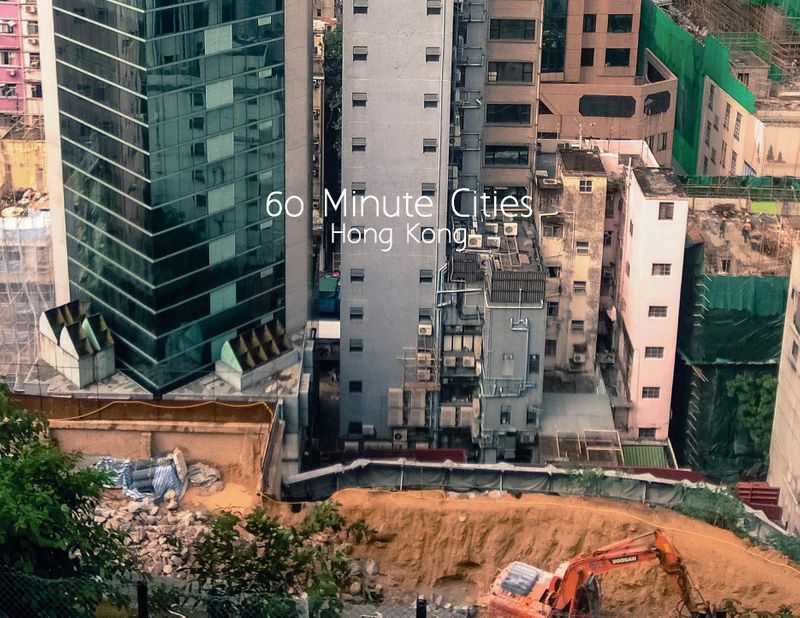60 Minute Cities: Hong Kong | 60分钟,我的城市- 香港

US $5 | RMB 30元
To listen and purchase please click below/ 聆听购买
[Purchase includes Mp3 audio files and PDF of track descriptions]
Look | 凝视
我在湾仔等公交车,因为这些抗议活动,我需要搭乘的公交线路停运了或者缩短了。我抬头看着朦胧的天空,看到几个黑色的风筝在几座玻璃大楼间滑过。我走上人行天桥,开始录音。我想像两只小鸟顺着温热的气流向上飞行一般跟随这些声音。我决定舍弃所有规则,只遵循一条:像一只游荡的微型耳机,沿着一条叫作可能性的轮廓线在空间走动。我穿过周围环境,划过我的立体声传声器,只捕捉在我左右两侧留下的两条短暂的声音痕迹。我游走在波动的人群中、人行干道的形状和间隔里、不完美和偶然的声景的区域线里。我不会停止走动,只是允许自己慢下来,或者加快速度,让步速和耳机里的压力波同步。
我沿着一条湾仔街市上到一个山坡,街市里混杂着叫卖小贩的吆喝、购物者拖沓的脚步声还有无线射频器发出的干扰声。我在铜锣湾一些小巷里环绕,循着金属工具的捶打声和维修店里电视和收音机发出的刺耳的声音在周围走着。突然下起了一阵雨,我穿过一个笼罩着人道主义光芒的小寺庙爬到斜坡上。一起爬坡的是一个推着空手推车的老人。直到有节奏感的教堂钟声响起,敦促着我向一条山路走去,夹杂着交通工具的轰鸣声和建筑工地方向发出的一些回响。我沿着一条小道穿过一条小溪,最终来到金钟,沿着空旷的街道和废弃的路障继续走。这天是2014年10月3日。
香港这座城市标志性的声音是一种高声调的交通工具尾音夹杂一些持续而遥远的低音,旧建筑的水泥骨架增强了这些声音的传播。这是你无法摆脱的一种声音,即使你逃离到香港公园最安静的角落。为了摆脱这种声音,我尝试走在一个巨大的瀑布背后,或者爬到Vantage Point Tower塔顶,结果发现塔顶就像一个巨大的抛物形反射器,接收了城市中西区的所有声响,聚拢在我录音机的话筒上,背景还点缀着水滴下的声音和Edward Youde鸟类饲养场里里外外几百只鸟的鸣叫声。一张不锈钢铁丝网分隔开繁茂的室内植被和头顶开阔的天空,我沿着它走着,觉得我临时起意走出来的这条路有些许讽刺:起初因为看到两只捕食的鸟联想到模仿它们的飞行路径跟随记录声音,最后走到了一个收集飞行物种的特殊行政区,在划给热带鸟类的围场里绕圈圈。我看到一只白色的鹦鹉在树上笑。
I was waiting for a bus in Wan Chai, and the routes I needed were suspended or shortened because of the protests. I looked up at the hazy sky and I saw a couple of black kites gliding among the glass towers. I walked up a pedestrian bridge and I started recording. I wanted to follow sounds in the same way the two birds soared on warm air currents. I decided to have no rules but one: moving as a wandering micro-ear-phone assemblage along the contour lines of chance. I passed through ambiences as they split up and slid past my stereo microphones, leaving as only trace two ephemeral contrails of sound on my left and my right. I glided up and down the fluctuating topographies of crowds, the shapes and breaks of pedestrian paths, the isoglosses of imperfect and fortuitous soundscapes. I would not stop walking, only allowing myself to slow down or accelerate in keeping with the pressure waves in my headphones.
I went up a hill through a Wan Chai street market ricocheting between the calls of hawkers, the shuffle of shoppers’ feet, and RFID intereferences. I circled around small roads in Causeway Bay, guided by the hammering of metal tools and the blaring of radios and TVs in repair shops. I climbed the slope under a burst of rain, through a small temple clad in a cloud of humidity, along an old man pushing an empty handcart, until rhythmic church bells propelled me towards a mountainous road breathing with the pace of roaring traffic and echoes of construction work. I sled down a path across a rivulet, ending up in Admiralty, skirting empty streets and deserted barricades. It is October 3rd, 2014.
The constant note of Hong Kong is a high-pitched reverb tail of traffic and voices, doubled by a constant, distant bass propagating in swells along the concrete bones of old buildings. It is a sound that you cannot escape even when you take refuge in the most tranquil parts of Hong Kong Park. Itried to cancel it by walking behind a huge waterfall, or by climbing up the Vantage Point Tower, reaching the top only to discover that its roof functioned as a huge parabolic reflector collecting the sounds of the Central and Western District and focusing them on the microphones of my recorder, punctuated by drips of water and the calls of hundreds of birds inside and outside the Edward Youde aviary. Moving along the stainless steel wire mesh separating a legitimate luxuriant interior vegetation from the illegitimate open sky outside, I found the vector traced by my improvised line of flight slightly ironic: spurred by the sight two birds of prey and by imitating their glide to follow sounds, I ended up circling around an enclosure for tropical birds, a Special Administrative Region for a collection of flying creatures. A white parrot laughed on a tree.
关于艺术家
Gabriele de Seta,又名"胡子哥"。Gabriele游走在欧洲和亚洲各地,前后研究过中文语言学和文化研究、人类学以及媒体理论,现居台北。他当下正在研究当代中国方言创造性与实践。他喜欢收集、搜索、叙述中国后数字媒体生态里流传的用户创造的不同体裁的内容、地方性幽默和有平台特色的审美元素。他也倒腾实地录音、试验性音乐以及互联网艺术。他刚刚完成一个社会学博士学位,由香港理工大学应用社会科学学院全额资助,研究方向是数字化的中国民间文学。
自2006年以来,Gabriele在中国各地表演他的试验性音乐,并于2007年创办了他自己的独立音乐品牌"Mostres par Excès",在中国及其他国家发行了一系列试验音乐作品。
Gabriele de Seta, also known as "Huzi Ge" ("Beard Bro" in Chinese). Moving around Europe and Asia, Gabriele hops back and forth from Chinese linguistics and cultural Studies to anthropology and media theory, and is now living in Taipei. He is currently studying practices of vernacular creativity in contemporary China. He collects, curates and narrates, the genres of user-generated content, local humor and platform specific aesthetics circulating across Chinese post-digital media ecologies. He also meddles with field recordings, experimental music, and Internet art. He recently completed a fully funded PhD in Sociology with a research project about Chinese digital folklore at the Hong Kong Polytechnic University, Department of Applied Social Sciences.
Since 2006 Gabriele has performed experimental music all around China, and has founded his own independent music label "Mostres par Excès" in 2007, releasing a series of experimental music works from China and beyond.

